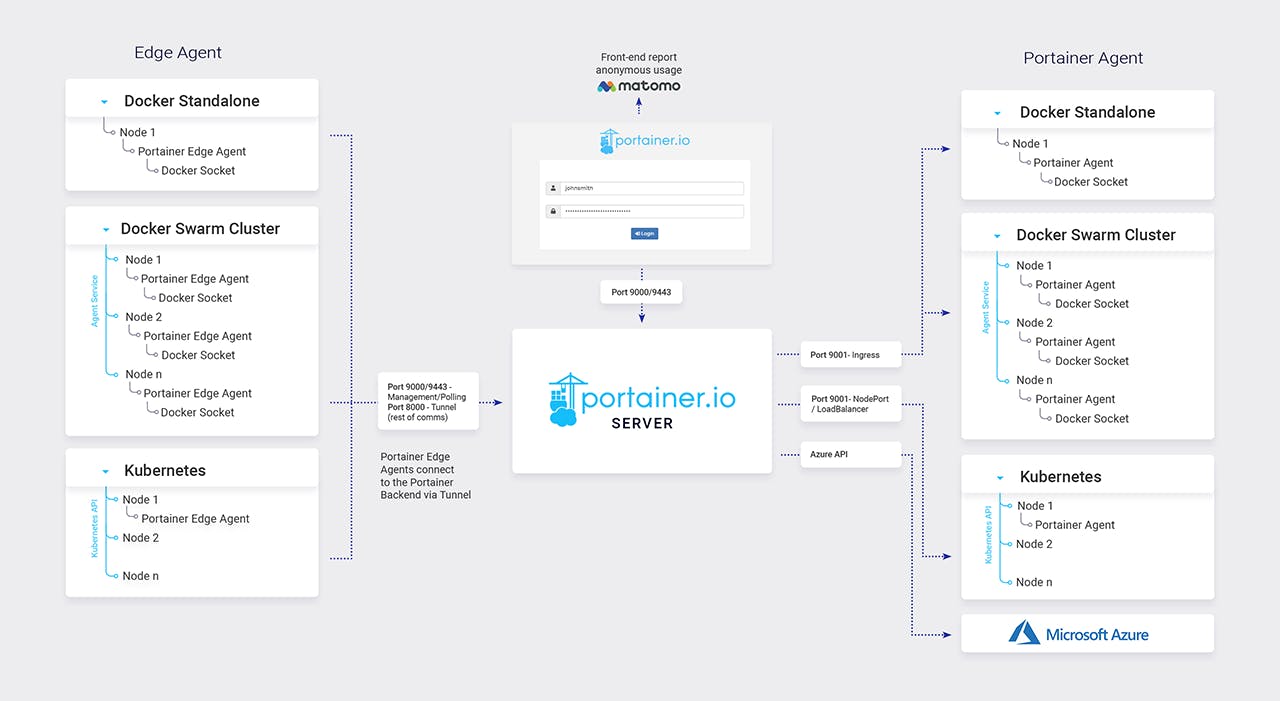1. What is Portainer?
Portainer is a universal and lightweight container management system or tool for Kubernetes, Docker/Swarm, and Nomad that simplified container operations so you can deliver software to more places faster.
2. Why Portainer?
Portainer is a centralized multi-cluster management platform. which is designed for an organization that does not have access to container management expertise, but wants to explore the power of containers today.
with an intuitive GUI codified best practice and cloud-native design templates Portainer reduces the operational complexity of multi-cluster container management. which speeds up adoption and reduces errors It addresses critical skill shortages by making the technology safely accessible to everyone inside the organization It simplifies the setting-up of 'safe' security configurations within Docker and Kubernetes through centralized IAM.
3. Portainer Architechture
Overview of Portainer architecture: Portainer consists of two elements: the Portainer Server and the Portainer Agent. Both run as lightweight containers on your existing containerized infrastructure. The Portainer Agent should be deployed to each node in your cluster and configured to report back to the Portainer Server container. A single Portainer Server will accept connections from any number of Portainer Agents, providing the ability to manage multiple clusters from one centralized interface. To do this, the Portainer Server container requires data persistence. The Portainer Agents are stateless, with data being shipped back to the Portainer Server container.

4. Portainer features
Application Development: At its heart, Portainer helps developers deploy cloud-native applications into containers simply, quickly, and securely.
Portainer has its own simplified GUI, which makes it easy for users to get started. For advanced users, Portainer incorporates an API that allows it to connect to CI/CD tools or third-party dashboards/deployment tools.
1. Manual deployment options
For users with limited to zero knowledge of containers Portainer’s custom Application Templates are the ultimate “click to deploy” bootstrap for getting commonly used applications up and running fast. The Custom Templates can also be used by developers to rapidly prototype and test against a disposable system, or for repetitive use cases such as QA. To use an Application Template, a user simply needs to deploy an application, tune/configure it as they wish, and then select the option to “save as template”. This application's configuration will now be available to “single-click deploy” any subsequent time.

Portainer’s support for HELM charts is limited to Kubernetes clusters, and provides users with the ability to deploy any application that is made available via the Bitnami HELM repo; alternatively, the Portainer administrator can connect Portainer to an internal repository, thereby restricting user deployments from only this trusted repo. Helm charts can be adjusted inside Portainer through our “values” editor, which lets you set whatever options are made available by the publisher of the HELM chart.
2. Automated deployment options Portainer is more than just a UI, Portainer can also act as a Continuous Deployment (CD) system. DevOps professionals are able to connect Portainer to their Git repos, and Portainer will automatically deploy any application defined in that repo, and ensure any changes that are made in Git are propagated to the running application. These redeploy can either be manual (where organizational policies require so), automated through webhooks (so the CI system can notify Portainer), or automated through our “poller” which checks for changes on a regular schedule.
